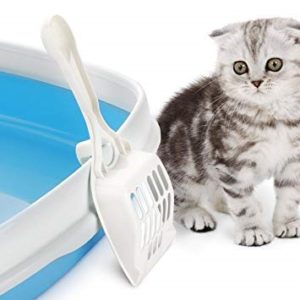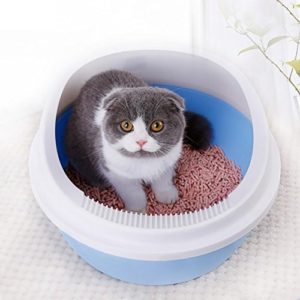Best Litter Box for Scottish Folds – A Complete Guide
How to choose your cat’s litter box and make sure they use it
As sweet as Scottish Folds are, they have the same physiological needs as we do. Although litter is the least glamorous part of taking care of a cat, it needs to be done right.
The right litter in the right box and spot will help you avoid unpleasant situations and keep your cat healthy. If the kitty is healthy and happy, so are you!
Putting some thought and effort into picking your cat’s box and litter will lead to establishing good habits for life. Let’s put some harmony into your home!

How to choose the litter box for your Scottish Fold
First instinct is to walk into a store, go to the kitty section and choose a box of your liking from what’s available. Wrong!
The litter box has to address your cat’s needs: size, height, depth, type. A cat that is uncomfortable with the box you provide, will most likely look for other places to go. Finding smelly “gifts” in the closet or under the bed is frustrating and unsanitary for both you and the cat.
-
Size of the litter box
Essential! The box needs to be large enough for your cat to move around, to dig and be able to avoid litter from earlier visits.
The common rule is:
Length: 1.5 times the length of your cat from nose to tail.
Width: at least as long as your cat.
A Scottish Fold is a medium-sized cat, this means about 45 cm long (18 inches). Thus, a large enough box should be at least 68 cm (27 inches) long and 45 cm (18 inches) wide. Of course, you can measure your cat for more precise calculation.
If you had in mind a particular place in the house for the litter box and these measurements don’t work for you, you might need to rethink the spot. Don’t sacrifice the size of the box for your own comfort. On the long term, if the cat is not happy, you will have more trouble with bad littering habits.
But what does the market offer!? The biggest litter boxes in pet stores don’t have more than 50-60 cm (20-24 inches) in length. For many cats, this could work.
Advice: give it time and try out different options. Every cat has unique preferences and they can tip you off on what works best for them. Be ready to change a few boxes.
 Height: on average 13-18 cm (5-7 inches)
Height: on average 13-18 cm (5-7 inches)
However, this will vary as well. Here are the things to consider:
Sprayer/kicker cat – is your Scottish Fold is a messy fellow and kicks litter all over the place? Then you want your box to be taller. But make sure your cat can get in and out with ease. Look for boxes with 3 tall sides and a lower one for entry and exit. Typically, you can find such a box with 20-30 cm (8-12 inches) sides and a 13-15 cm one for access.
Mobility problems – if you have a baby cat or a Scottish Fold with arthritis or low mobility, you will need an easy-access box. Aim for boxes that have at least one very low side for getting in and out.
-
Type of litter box
 This is where you need to work up the patience to test different options. Scottish Folds, although they belong to the same breed, have particular personalities. Your Fold will not enjoy the same things that your neighbor does. Thus, go wild on experimenting with types of litter boxes.
This is where you need to work up the patience to test different options. Scottish Folds, although they belong to the same breed, have particular personalities. Your Fold will not enjoy the same things that your neighbor does. Thus, go wild on experimenting with types of litter boxes.
Covered box
Covered box – a good idea for you, not so good for the cat. The closed space keeps the smell in and away from you. At the same time, that contained smell will keep your cat away. It’s like a Porta-Potty for cats. How much do you enjoy using those!?
Felines prefer open spaces where they don’t feel trapped. They have an open view over potential threats and can escape if need be.
Also, covered boxes come in different models. The entry point can be a flap door, a front hole or one at the top of the box. Either way, they don’t offer easy access, especially for cats with special needs or mobility issues.
Uncovered boxes
Uncovered boxes – the most common ones. As long as it is big enough with room to turn and dig, it is a good option for most cats.
The smell might not be pleasant, but you signed up for this the second you brought a cat home. If you keep it clean and tidy, the smell is not a problem.
Self-cleaning boxes
Self-cleaning boxes – say no more, it is heaven for owners. For cats though, these boxes are not that convenient. Neither is the price.
Although you will never have to scoop, your cat pet might grow scared of it. The noise from the automatic cleaning process can startle your sharp cat. In the future, they might choose to avoid it.
Moreover, these boxes need disassembling and cleaning every few weeks. The enclosed design traps the odors in which has the same effect as the covered boxes. Not to mention that they are quite small in size.
Scottish Folds are a breed with potential health problems like stiff legs and tail. They are prone to joint issues and arthritis that leave them with a low range of movement. Covered boxes with tight entrances can be problematic.
 Solution: A good litter box is not found in the kitty section or in a pet store. Plastic storage containers make awesome litter boxes. They are big enough, with tall sides. The translucent material helps the cat see around and feel safe.
Solution: A good litter box is not found in the kitty section or in a pet store. Plastic storage containers make awesome litter boxes. They are big enough, with tall sides. The translucent material helps the cat see around and feel safe.
For low mobility cats and general ease of access, you can cut one of the sides to be lower.
Best Litter Box for a Scottish Fold and British Shorthair
Here are some top litter box picks for a Scottish Fold or British Shorthair:
IRIS Top Entry Cat Litter Box with Scoop
Good Pet Stuff Company Hidden Cat Litter Box
PetSafe ScoopFree Ultra Self-Cleaning Cat Litter Box
CatGenie Self Washing Self Flushing Cat Box
Catit Jumbo Hooded Cat Litter Pan
How to set up the litter box
First of all, a helpful tip is to adjust the number of litter boxes to how many cats you have. Ideally, you should get more than one box following the n+1 rule. If you have one cat, consider keeping 2 boxes.
Cats develop weird patterns and there are many reasons why they might not use the same box twice until scooped.
Position & place:
- Easy to enter and exit the box
- Enough space between the boxes (if you have more than one) or around the box
- Good ventilation
- No carpets or rugs for easy cleaning
Avoid placing the box where there’s a lot of foot traffic or that is noisy. Cats will get startled and uncomfortable.
Litter amount:
The right amount of litter will make the difference. It depends on your cat’s behavior, whether it likes to dig or not if it buries the poop deep or not.
How often you scoop and the type of litter you use also matters.
Recommended depth is around 6-8 cm (2-3 inches). Replenish every time you scoop to keep a constant level.
Tip: If you use more than one box, be sure to keep them all clean. Also, try to place them away from one another. If put next to each other, the cat will treat them like one big litter pool.
What are the best litters for Scottish Folds?
Even if cats can get picky, litter does not pose a big problem. There are a few aspects that most cats accept and your Scottish Fold will too.
Small particles: since the modern litter is on the market, cats seem to like the small-particle one better. The fine particles feel better on their paws.
 Unscented: cats have a great sense of smell. Strong scents seem to bother them, so they prefer the odorless version. Don’t worry about the smell. As long as you constantly engage in scooping and cleaning, the smell should not be disturbing.
Unscented: cats have a great sense of smell. Strong scents seem to bother them, so they prefer the odorless version. Don’t worry about the smell. As long as you constantly engage in scooping and cleaning, the smell should not be disturbing.
Clumping: this litter contains bentonite that helps absorb the urine. It forms a solid lump that you can easily pick up and throw. The granules are small which is a ‘yes’ for the cat.
Bad litter habits and how to deal with them
Is your Scottish Fold doing business outside the litter box? Let’s go through some of the reasons and how to fix it.
Pooping & peeing outside the box
- Medical problems – take your dear cat for a veterinarian check.
- Intestinal problems can produce cramping and pain.
- Kidney infections
- Bladder infections or inflammation
- Dehydration
If the cat suffers, it might choose to go somewhere out of sight or where it can get in a better position. Also, the poor fellow might not be able to make it to the litter box.
- Feline survival instincts – some cats don’t like to poop in the same place where they urinate. Set a different box for defecation and place it at a distance from the other one.
- Placing of the box – if there is not enough room for your cat to sit in a proper position, it will choose to go someplace else. When pooping, they sit upwards and use the margins for support. Learn their behavior and adapt to their needs.
- Cleanliness – if the box is dirty and unscoped, they will rather not go. You don’t have to install a radar and clean the second they are done. But do make sure they can find a clean patch of litter every time.
- Litter – if they don’t like the litter type or amount, they will choose the area next to the box. Soft, sandy litter seems to do the trick for most cats.
There’s a lot more to cover on Scottish Fold’s hygiene routines and preferences. If you are invested in doing what’s best for your cat, research and patience will be your friends. Getting to know your cat and their behavior adds value to your efforts. Aim to please both your needs and your cats’ – clean house, clean cat, happy family. How’s your Scottish Fold responding to litter training!?